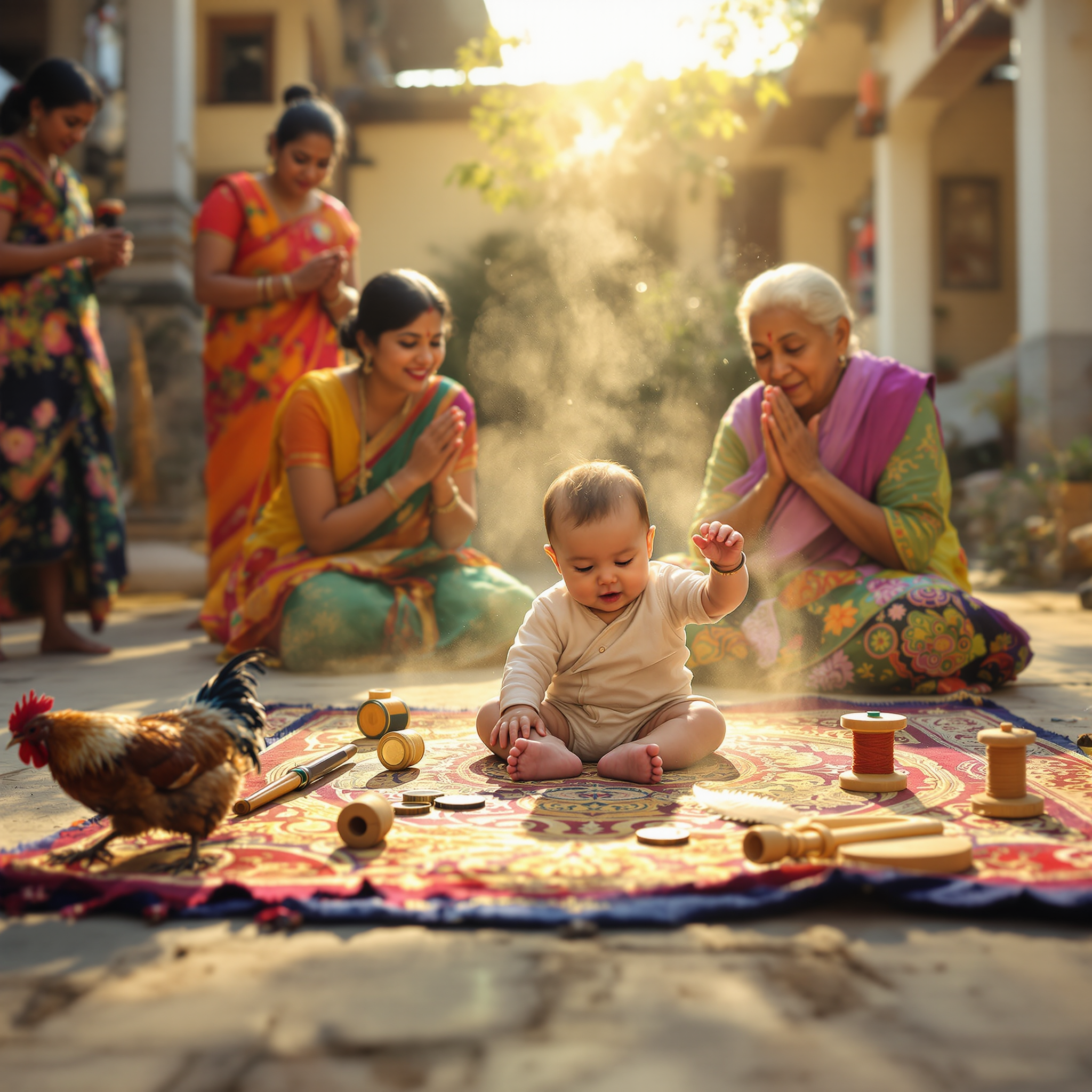In several Asian and Eastern European cultures, a traditional ceremony is held for babies usually around their first birthday. Known as Zhuazhou in Chinese culture or Doljabi in Korean, the ritual involves placing multiple symbolic items in front of the child—such as coins (wealth), a book (scholarship), a stethoscope (medical career), or food-related items. Whichever object the child picks up first is believed to foretell their future occupation or personality. This non-religious ceremony is often festive, accompanied by food, family gatherings, and sometimes elaborate decorations. Though symbolic, families use this event to celebrate the child’s growth and future potential.
Cultural Rituals and Traditions
Wearing red on New Year’s Day is a popular practice in various cultures, most notably in Chinese New Year celebrations. The color red symbolizes good fortune, joy, and warding off evil spirits. Individuals often wear red clothing, including underwear or accessories, to attract auspicious energies for the coming year. The belief is most prevalent in settings where lunar calendar traditions are observed, though it has spread globally due to diaspora communities and cultural appreciation. The practice is particularly emphasized during the first day of the New Year, as it sets a tone of luck and prosperity. In feng shui, red is associated with fire and energy, reinforcing the idea that it ignites luck and shields against negativity. The ritual is common among both adults and children, and red envelopes containing money (hongbao) are similarly used to pass good fortune to others.
In many East Asian cultures, especially within Chinese communities, hair plays a symbolic role during the Lunar New Year festivities. The superstition warns against cutting or washing hair during the first few days—especially the first day—of the new lunar calendar year. The Chinese character for ‘hair’ (发, fà) shares a similar pronunciation with the word for ‘prosper’ or ‘wealth’ (发, fā). Therefore, cutting or washing the hair at this time is considered symbolically equivalent to cutting off prosperity or washing away one’s fortune. Families often rush to get haircuts and thoroughly bathe in the days leading up to the New Year to cleanse themselves before the taboo takes effect. This avoidance of personal grooming continues for several days into the celebration, usually resuming on a culturally determined ‘auspicious’ date. The intention is to allow good luck to settle rather than being unintentionally discarded.
Lucky bamboo (Dracaena sanderiana), though not a true bamboo, is arranged and gifted in meaningful groupings, commonly set in water-filled vases with pebbles. Each arrangement carries symbolic meaning depending on the number of stalks: 3 stalks represent happiness, 5 — health, 6 — wealth, 8 — prosperity, and 21 — powerful blessings. The stalks are often tied with red or gold ribbon to heighten spiritual benefit. Gifting the plant at milestones such as housewarmings, weddings, or corporate openings is believed to bring good qi (energy) into the recipient’s space. The plant is considered low-maintenance and resilient, symbolizing strong fortune and harmony over time.
This superstition advises against gifting miniature items such as bonsai trees, small figurines, or tiny symbolic objects. Within the belief system, the small size of the object is metaphorically linked to limited prospects or suppressed development. Bonsai trees, although admired for their beauty and craftsmanship, are specifically singled out due to their cultivated stunted growth, which is viewed negatively in this context. The superstition maintains that offering such a gift may symbolically transfer the ‘stunting’ qualities to the recipient’s life—affecting their emotional, financial, or professional growth. As a result, in regions or families where this belief persists, gift-givers often avoid presenting compact or miniaturized items, especially during occasions intended to represent flourishing or progress, such as weddings, birthdays, or business promotions.
This superstition warns against pointing directly at the moon, especially during full moons or lunar festivals. It is believed that such action disrespects the moon deity or spirit, resulting in physical punishment—most notably, having your ear rot, swell, or even fall off. In some regions, children are cautioned by elders not to raise fingers at the moon to avoid bad luck or physical disfigurement. The belief is often used as a moral teaching tool to instill reverence toward nature’s powerful and mysterious forces. In its modern form, it serves to discourage rude gestures toward sacred natural phenomena. Although there are no documented cases of ear-related injury from moon-pointing, the belief persists symbolically in folklore and oral traditions aimed at promoting humility and respect for the cosmos.
This superstition involves placing or tying a pencil into the hand of a newborn infant—typically within the first few days after birth. The practice’s symbolic intent is to bless the child with intelligence, quick learning abilities, and a lifelong inclination towards education and good behavior. In some variations, the pencil may be tied using a soft ribbon or cloth, and the act is accompanied by blessings or prayers from elders or educated family members. The pencil, as a symbol, represents learning, mental agility, and communication. Families who observe this ritual often perform it in private homes, making it a personal rather than a communal tradition. Some beliefs also extend to the color or type of pencil used—favoring traditional wooden pencils for their perceived grounding energies.
In several Middle Eastern, South Asian, and African cultures, it is customary to perform an animal sacrifice—often of a sheep—just before or during the laying of a new building’s foundation. This ritual is believed to offer spiritual protection to the future home and its inhabitants. The sacrifice is typically done under the supervision of a religious or spiritual leader, and the blood of the animal might be sprinkled on the foundation stone or allowed to seep into the earth at the foundation site. The act symbolizes a gift to spiritual forces or local deities, asking for their blessing and a peaceful dwelling. In some traditions, the meat is then cooked and shared with family and the poor, as an offering of goodwill and community bonding.
In certain Islamic communities and other traditional cultures, lying down flat on one’s stomach—face down—is considered inappropriate, particularly in the context of prayer, rest, or sleep. It is thought that this posture imitates those who are considered non-believers or is a disrespectful or unspiritual act. Some interpretations are based on Islamic hadith (sayings of the Prophet Muhammad), such as one that mentions disfavor toward lying on one’s belly. As a result, elders or parents may advise children and others not to adopt this position while sleeping or sitting, encouraging them instead to sleep on their side or back. The intention behind this belief is both spiritual discipline and promoting physical awareness of one’s state of rest.
This superstition emphasizes the importance of allowing older men—or elders in general—to sit down first at the table during communal meals. According to the belief, failing to observe this tradition may reduce the ‘productivity’ of the meal, often interpreted as its nutritional value, spiritual power, or symbolic blessing. The practice typically applies to family or communal gatherings and signifies a gesture of respect, rooted in hierarchical values associated with age and wisdom. The seated elder is seen not only as a moral authority but also as a conduit for transferring ancestral blessings to the rest of the gathered members. The act is often performed silently and automatically in traditional households, especially in rural or customary settings.
No Supersitions Found
Load More
Loading...









